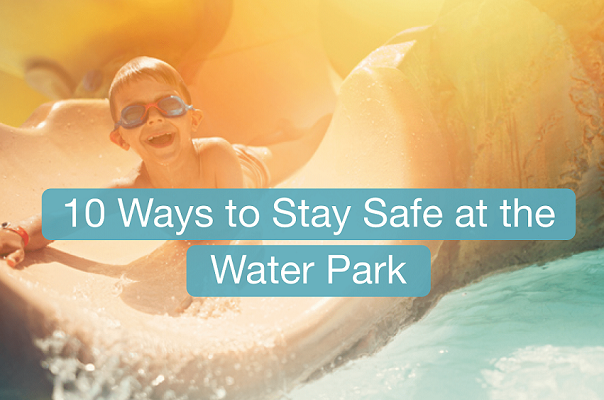10 Ways to Stay Safe at the Water Park

1. Dress for the day.
You’ll be outside, in the heat, most of the day. You need to dress appropriately to keep from getting sunburned, experiencing heat stroke, or getting dehydrated. This includes wearing water shoes, a hat and a loose t-shirt when you need a break from the water, and sunglasses. Be sure to keep a close eye on younger children and monitor how much time they have in the direct sunlight.
2. Wear sunscreen.
Along those same lines, be sure to apply waterproof sunscreen 30 minutes before you arrive at the park and reapply it throughout the day. Waterproof sunscreen needs to be reapplied every 80 minutes if you’ve been in the water, especially if you’ve dried yourself off with a towel in between applications. The FDA also recommends using a lip balm with SPF 15 or higher while in the sun.
3. Stay hydrated.
Being in the sun all day and playing in the water can get your body dehydrated rather quickly. Drink plenty of water and try to avoid any caffeinated sodas or drinks with artificial sweeteners. These beverages will contribute to dehydration, so water is always your best option. You’ll need more water than you usually drink when inside because you’ll perspire out a lot of the hydration.
4. Keep an eye on your kids.
You need to know where your kids are at all times at the water park. Even if there is a lifeguard on duty, don’t depend on them. Always watch your children or be in the water with them. Lifeguards are responsible for scanning large areas and can sometimes miss things. Plus, it’s not their responsibility to baby sit children and should only be used in case of emergencies, which you don’t want to encounter.
5. Know the four “toos.”
There are some “toos” that can quickly turn to dangerous circumstances if not monitored correctly. Don’t get too tired, too cold, too far from safety, or too exposed to sun. If you notice your children mentioning any of things or if your instincts tell you the family has been in the sun too long, take a break in a shady spot or go indoors.
6. Wear a life vest.
According to an American Red Cross survey, 30 percent of parents think floaties are an appropriate substitute for supervision. No matter how old your children are, a life vest should be worn and an adult should supervise at all times.
7. Know the rules.
Each park has different rules, so be sure to read all posted signs before sending your children off to enjoy the fun. Water parks are filled with different features and slides, each appropriate for different ages. Read all safety procedures and precautions relating to height, age, swimming ability, and medical condition. Be sure to follow the rules and ask the lifeguards or staff if you have any questions.
8. Don’t run around the pool.
It’s easy to get caught up in the excitement, but it’s important to remember not to run around the park to keep everyone safe. Running on slippery decks or sidewalks can be very dangerous. Avoid an unnecessary trip to the emergency room for stitches or a broken leg by simply walking instead of running while in the park.
9. Know how to swim.
Every member of the family should at least know the swimming basics before going to the water park. The best thing for anyone to do to stay safe in water is to know how to swim. Both adults and children should know how to swim to help avoid drowning accidents. Teach them at home if you have a backyard pool, or consider signing your children up for swimming lessons to help get them comfortable.
10. Keep young children in shallow areas.
There are different areas with varying water depth levels at most water parks. Keep younger children and toddlers in the shallow play areas. Most water parks have zero-depth entry pool with sprays, fountains, and water games that may be better suited for your younger children than going on any of the water slides or in the pool.
What safety tips do you have for water park fun?
Written by Hillary Johnston
A proud mother of four, Hillary is passionate about safety education. She holds a degree in Public Health and Disaster Management. Learn more